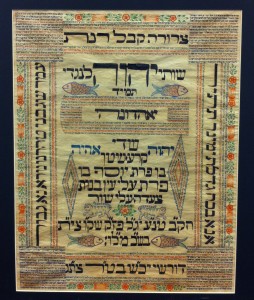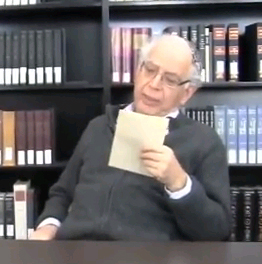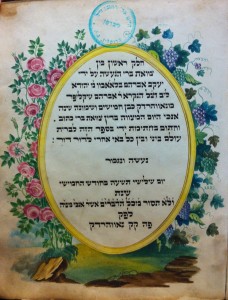
Marriage contract, manuscript, ink and paint on vellum, dated 26th of
Av 5617 at Roma (1857), 79 x 45 cm.
Bridegroom: Matsliaḥ ben Mosheh Eliyahu mi-Ṿeroli.
Bride: Gratsya bat Aharon Menifi.
Witnesses: Ḥayim ben Avraham and one other.
The text is written in Italian block letters and is enclosed in a double border with sections framed in red. On the top, in the center register are two figures from biblical times who are appear to be serving wine. On either side are two images relating to the biblical story of the binding of Isaac (Gen. 22:2-14). On the bottom, in the center, are two figures in contemporary attire also serving celebratory drinks.
On either side, are images of two couples dressed in contemporary dress, who appear to be bridal couples.


Other sections contain decorative elements including rams horns, doves, coats of arms, flowers and geometric designs.
The bottom is scalloped with a stylized vase in the center of the triangle, which is typical of ketubot from Rome.


This is a marriage contract, manuscript, ink on vellum, dated 12 of Shevat, 5550 at Sienah (1790), 62 x 42 cm.
Bridegroom: Yedidyah Menaḥem ben Aharon Ḥayim Galiḳi.
Bride: Leʼah de-hot mitḳare Avigail Ḥaṿah Tamar bat ha-manoaḥ Avraham Barukh Ḥaviv.
Witnesses: Yedidyah ben Refaʼel Shelomoh Segal, Yitsḥaḳ ben Sheneʼur?.
The ketubah is elaborately illuminated with colorful vignettes and floral and geometric designs.

The top of the ketubah is shaped in a triangle in which are contained benedictory statements for the bride and groom, verses from Proverbs 31:10-31 (a woman of valor…”), depictions of exemplary women in Italian dress, and depictions of putti, all surrounded by decorative elements.
On either side of the text are symbols of the zodiac, and at the bottom is a vignette
of Adam and Eve.

Manuscript in Hebrew and Yiddish. In this will Avraham Shklifer, evidently a wealthy merchant without children, leaves instructions for the distribution of his estate including bequests to talmudic academies, book publishers, hospitals, and other Jewish communal institutions. The document mentions several important leaders of the community of Novogrudok, Belarus and Vilna.
This quite lengthy will is mostly in Hebrew and not in Yiddish, the spoken language of the Jewish population of the region. It has a red wax seal at the conclusion. The graphic illustrations on the first two pages are also unusual. The two angels on the second page seem to have an Italian influence. The document is in its original binding. The stamp of one of the previous owners, Hayyim bar Reuven Lieberman, appears on several of the pages.
Since we mostly know more about the poor Jews who lived in Eastern Europe, it is quite a novelty to learn about the holdings, property, and way of life of a very wealthy one.
Shiviti plaque : [Italy?], [twentieth century?]

This type of plaque was usually hung in a synagogue and was meant to exhort the congregation to more devout prayer.
Manuscript, ink and paint on paper. The document is illuminated with colorful biblical scenes and incudes the traditional Shiviti statement “I have set the Lord always before me” (Psalm 16:8) and Psalm 67 written in the design of the seven-branched candelabrum. The biblical scenes on the bottom depict the sacrifice of Isaac (Genesis) and Samson’s struggle with the lion (Judges). On the top are three images: one is David slaying Goliath (Samuel I), in the center are the priests carrying the Holy Ark, and the third is a depiction of the Western Wall in Jerusalem. In the center of the plaque above the two smaller candelabra are depictions of Moses holding the Ten Commandments and Aaron, the High Priest, holding an incense burner. There are biblical scenes on either side of the plaques as well. At the bottom of the document in the center is a statement that the scribe is Amram Asiag bar Masud but no date is given.
Shiviti plaque : [Italy?], [twentieth century?]

Manuscript, ink and paint on paper. The entire text is calligraphed in colorful, decorative micrography. The traditional Shiviti statement “I have set the Lord always before me” (Psalm 16:8) appears in large bold letters on the upper register. Two fish appear in the below God’s name and at the bottom of the plaque; they represent fertility. The text on the document written in Hebrew block letters consists of biblical and liturgical passages that deal with blessing and God’s beneficence. The calligraphy is an integral part of the design of the document. There is a floral border along the outer edge that is beautifully executed and whose color scheme blends in with the art and calligraphy of the plaque. The shiviti is unusual in that it does not contain the seven branch candelabra in calligraphic form that is at the center of most shiviti plaques. The manuscript appears to be Italian because manuscripts from Italy are written in block letters similar to those that appear in this one.

Click here to view a video in which Professor Bar-Asher demonstrates how a sermon is chanted among Moroccan Jews.












